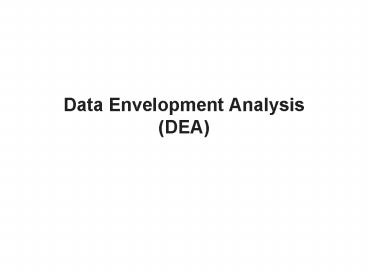Data Envelopment Analysis DEA - PowerPoint PPT Presentation
1 / 24
Title:
Data Envelopment Analysis DEA
Description:
... trade-off between the number of surgeries and exams that ... DEA (Charnes, ... DEA Summary. Addresses fundamental productivity measurement ... – PowerPoint PPT presentation
Number of Views:197
Avg rating:3.0/5.0
Title: Data Envelopment Analysis DEA
1
Data Envelopment Analysis(DEA)
2
Which Unit is most productive?
DMU labor hrs. cust. 1 100
150 2 75 140 3
120 160 4 100
140 5 40 50
DMU decision making unit
3
Extending to multiple outputs ...
Ex Consider 8 M.D.s working at a hospital for
the same 160 hrs. in a month. Each performs exams
and surgeries. Which ones are most productive?
Note There is some efficient trade-off between
the number of surgeries and exams that any one
M.D. can do in a month, but what is it?
4
DEA (Charnes, Coopers Rhodes 78)A
multiple-input, multiple-output productivity
measurement tool
Basic intuition (DMU decision making unit)
DMU labor hrs. cust. cust/hr. 1 100
150 1.50 2 75
140 1.87 3 120 160
1.33 4 100 140 1.40 5
40 50 1.25
cust.
200
x
slope 1.87
x
x
DMUs 1,3,4,5 are dominated by DMU 2.
x
100
x
labor hrs.
50
100
5
Efficient M.D.s These two M.D.s (1 and 6)
define the most efficient trade-off between the
two outputs.
Scatter plot of outputs
6
efficient frontier
1
These points are dominated by 1 and 6.
6
How bad are the inefficient M.D.s and where are
the gaps?
5
Performance gap
73.4 of distance to frontier
Efficiency score 73.4
7
Nearest efficient points define a reference set
and a linear combination of the reference set
inputs and outputs defines a hypothetical
composite unit (HCU)
Reference set for 5 is 1,6
6
5
1
HCU
8
DEA summary so far
- DEA uses an efficient frontier to define multiple
I/O productivity. - Frontier defines the (observed) efficient
trade-off among inputs and outputs within a set
of DMUs. - Relative distance to the frontier defines
efficiency - Nearest point on frontier defines an efficient
comparison unit (hypothetical comparison unit
(HCU)) - Differences in inputs and output between DMU and
HCU define productivity gaps (improvement
potential) - How do we do this analysis systematically?
9
Productivity
Reality more complex ...
Inputs
Outputs
Technology Decision Making
equipment
type A cust.
facility space
type B cust.
server labor
quality index
mgmt. labor
oper. profit
10
Operating Units Differ
- Mix of customers served
- Availability and cost of inputs
- Facility configuration
- Processes/practices used
- Examples
- bank branches, retail stores, clinics, schools,
etc. - Questions
- How do we compare productivity of a diverse set
of operating units serving a diverse set of
markets? - What are the best practice and under-performing
units? - What are the trade-offs among inputs and outputs?
- Where are the improvement opportunities and how
big are they?
11
Some approaches
- Operating ratios
- e.g. Labor-hrs/transaction, sales/sq.-ft.
- Good for highly standardized operations
- Problem Does not reflect varying mix of inputs
and outputs found in more diverse operations - Financial approach Convert everything to money!
- Problems?
- Some inputs/outputs cannot be valued in Rupee
(non-profit) - Profitability is not the same as operating
efficiency (e.g. variances in margins and local
costs matter as well)
Monetary Inputs
Monetary Outputs
12
Profitability vs. efficiency
- Profitability is a function of 3 elements
- Input prices (costs)
- Output prices
- Technical efficiency (How much input is required
to generate the firms output.) - Improving operations requires understanding
efficiency not just overall profitability.
13
LP Formulation
Data
Model variables
14
To evaluate a give unit, e, choose nonnegative
weights to solve ...
Which can be formulated
Normalize weighted input of e to one
15
Output analysis
These dual variables can be used to construct an
efficient hypothetical composite unit (HCU) with
Output j of HCU
Input i of HCU
Satisfying
16
Burger Palace Example
17
Burger Palace Example
18
Burger Palace Productivity Frontier
S1 (2,200)
S2 (4,150)
S3 (4,100)
S4 (6,100)
S5 (8,80)
C (5.3, 88.9)
S6 (10,50)
19
Summary of results
20
Summary of results
21
Using the results Efficiency Profit Matrix
High Profit
Under-performing potential leaders
Best practice comparison group
Low Eff.
High Eff.
Under-performing possibly profitable
Candidates for closure
Low Profit
22
Designing DEA Studies
- Inputs/Outputs
- K gt 2(NM)
- Ambivalence about inputs and outputs - all
should be relatively important! - Approximate similarity among DMUs.
- objectives
- technology
- Provides relative efficiency only.
- choice of units to include matters
- inclusion of global leader unit may be
desirable - Experimenting with different I/O combinations may
be necessary.
23
DEA Summary
- Addresses fundamental productivity measurement
problems due to ... - complexity of service outputs
- variability in service outputs
- Takes advantage of service operating environment
- large numbers of similar facilities
- diversity of practices/management/environment
- Provides useful information
- objective measures of productivity
- reference set of comparable units
- excess use of inputs measure
- returns to scale measure
24
DEA Summary (cont.)
- Role of DEA
- data mining to generate hypotheses
- evaluation/measurement
- benchmarking to identify best practice units
- Caveats
- black box - No information on root causes of
inefficiency - Be aware of assumptions (e.g. linearity)
- Can be sensitive to selection of inputs/outputs































